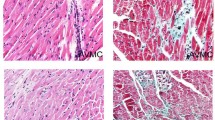Abstract
The purpose of the present study was to determine whether lymphokine activated killer (LAK) cells were involved in the development of coxsackievirus B3 (CB3) myocarditis in both the acute viremic (Experiment I) and the subacute aviremic (Experiment II) stages. To induce LAK cells, recombinant human interleukin-2 (IL-2) was administered to CB3-infected mice subcutaneously daily, starting on day 0 in Experiment I and on day 7 in Experiment II for 7 days, respectively. The treated groups were compared to infected controls. Splenic lymphocytes of IL-2 treated mice were further cultured in vitro in IL-2 containing medium for 7 days, and LAK cell activity, i.e., cytotoxic activity of the lymphocytes against EL-4 tumor cells and against cultured fetal myocytes, was assayed by51Cr-release method. In Experiment I, histologic scores, myocardial virus titers, and LAK cell activity did not differ significantly between IL-2 treated and untreated groups. In contrast, in Experiment II, there were more cellular infiltration associated with severe necrosis and higher LAK cell activity against EL-4 cells and cultured myocytes in IL-2 treated than in untreated groups. The presence of LAK cells was demonstrated in the subacute stage of murine CB3 myocarditis. Thus, the behavior of LAK cell activity may vary with the course of myocarditis, and enhanced LAK cell activity may be involved in the development of the disease.
Similar content being viewed by others
References
Abelmann WH (1971) Virus and the heart. Circulation 44: 950–956
Chang AE, Hyatt CL, Rosenberg SA (1984) Systemic administration of recombinant human interleukin-2 in mice. J Biol Response Mod 3: 561–568
Dec GW Jr, Palacios IF, Fallon JT, Aretz T, Millis J, Lee DCS, Johnson RA (1985) Active myocarditis in the spectrum of acute dilated cardiomyopathies. N Engl J Med 312: 885–990
Estrin M, Huber SA (1987) Coxsackievirus B-3 induced myocarditis. Autoimmunity is L3T4+ helper cell and IL-2 independent in Balb/c mice. Am J Pathol 127:335–341
Estrin M, Smith C, Huber SA (1986) Coxsackievirus B-3 myocarditis. T-cell autoimmunity to heart antigens is resistant to cyclosporine-A treatment. Am J Pathol 125: 244–251
Grimm EA, Mazumder A, Zhang HZ, Rosenberg SA (1982) Lymphokine-activated killer cell phenomenon. Lysis of natural killer-resistant fresh solid tumor cells by interleukin 2-activated autologous human peripheral blood lymphocytes. J Exp Med 155: 1832–1841
Huber SA, Job LP, Woodruff JF (1980) Lysis of infected myofibers by coxsackievirus B3-immune T lymphocytes. Am J Pathol 98: 681–694
Huber SA, Lodge PA (1984) Coxsackievirus B3 myocarditis in Balb/c mice. Evidence for autoimmunity to myocyte antigens. Am J Pathol 116: 21–29
Huber SA, Polgar J, Schultheiss P, Schwimmbeck P (1994) Augmentation of pathogenesis of coxsackievirus B3 infections in mice by exogenous administration of interleukin-1 and interleukin-2. J Virol 68: 195–206
Kawai C (1971) Idiopathic cardiomyopathy. A study on the infectious-immune theory as a cause of the disease. Jpn Circ J: 765–768
Kishimoto C, Abelmann WH (1989) Monoclonal antibody therapy for prevention of acute coxsackievirus B3 myocarditis in mice. Circulation 79: 1300–1308
Kishimoto C, Abelmann WH (1989) Absence of effects of cyclosporine on myocardial lymphocyte subsets in coxsackievirus B3 myocarditis in the aviremic stage. Circ Res 65: 934–945
Kishimoto C, Misaki T, Crumpacker CS, Abelmann WH (1988) Serial immunologic identification of lymphocyte subsets in murine coxsackievirus B3 myocarditis: different kinetics and significance of lymphocyte subsets in the heart and in peripheral blood. Circulation 77: 645–653
Lanier LL, Benike CJ, Phillips JH, Engleman EG (1985) Recombinant interleukin-2 enhanced natural killer cell-mediated cytotoxicity in human lymphocyte subpopulations expressing the Leu 7 and Leu 11 antigens. J Immunol 134: 794–801
Leonard WJ, Depper JM, Robb RJ, Waldmann TA, Greene WC (1983) Characterization of the human receptor for T-cell growth factor. Immunology 80: 6957–6961
Lotze MT, Grimm EA, Mazumder A, Strausser JL, Rosenberg SA (1981) Lysis of fresh and cultured autologous tumor by human lymphocytes cultured in T-cell growth factor. Cancer Res 41: 4420–4425
Mule JJ, Shu S, Schwarz SL, Rosenberg SA (1984) Adoptive immunotherapy of established pulmonary metastases with LAK cells and recombinant interleukin-2. Science 225: 1487–1489
Mule JJ, Yang JC, Afreniere RL, Shu S, Rosenberg SA (1987) Identification of cellular mechanisms operated in vivo during the regression of established pulmonary metastases by the systemic administration of high-dose recombinant interleukin 2. J Immunol 139: 285–294
Nakamura TY, Yamamoto I, KannoY, Shiba Y, GoshimMa K (1994) Metabolic coupling of glutathione between mouse and quail cardiac myocytes and its protective role against oxidative stress. Circ Res 74: 806–816
Paque RE, Gauntt CJ, Nealon TJ, Trousdale MD (1978) Assessment of cell-mediated hypersensitivity against coxsackievirus B3 viral-induced myocarditis utilizing hypertonic salt extracts of cardiac tissue. J Immunol 120: 1672–1678
Ryes M, Lerner AM (1985) Coxsackievirus myocarditis. With special reference to acute and chronic effects. Prog Cardiovasc Dis 27: 373–394
Rosenstein M, Yron I, Kaufmann Y, Rosenberg SA (1984) Lymphokine-activated killer cells. Lysis of fresh syngeneic natural killer-resistant murine tumor cells by lymphocytes cultured in interleukin 2. Cancer Res 44: 1946–1953
Saijo N, Ozaki A, Nakano H, Sakurai M, Takahashi H, Sasaki Y, Hoshi A (1986) In vivo augmentation of the cytotoxity of spleen lymphocytes against syngeneic B-16 melanoma cells and the suppression of the artificial metastases in C57BL/6 mice by subcutaneous multiple injections of high dose human recombinant interleukin-2 (rIL-2). J Cancer Res Clin Oncol 111: 182–186
Weibel ER, Kistler GS, Scherle WF (1966) Practical stereological methods for morphometric cytology. J Cell Biol 30: 23–38
Woodruff JF, Woodruff JJ (1974) Involvement of T lymphocytes in the pathogenesis of coxsackievirus B3 heart disease. J Immunol 113: 1726–1734
Woodruff JF (1980) Viral myocarditis. A review. Am J Pathol 101: 427–479
Author information
Authors and Affiliations
Additional information
This work was supported by research grants from the Conference on Coronary Artery Disease, Japanese Education of Science and Walfare (Nos. 08877110 and 09470164), Kanae Shinyaku Foundation, and Japan Cardiovascular Research Foundation.
Rights and permissions
About this article
Cite this article
Kishimoto, C., Kuroki, Y., Kurokawa, M. et al. Lymphokine activated killer cells in murine coxsackievirus B3 myocarditis. Basic Res Cardiol 92, 402–409 (1997). https://doi.org/10.1007/BF00796214
Received:
Revised:
Accepted:
Issue Date:
DOI: https://doi.org/10.1007/BF00796214




